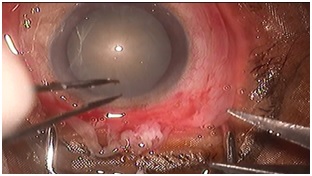A journey of postgraduate in acquiring skills of manual SICS
Abstract
Introduction: Cataract surgery is the most common surgery in ophthalmology. It is the stepping milestone of every budding ophthalmologist during postgraduate tenure. The learning pattern of surgical steps can provide better understanding about division of postgraduate’s curriculum.
Material and Method: 60 cases underwent manual small incision cataract surgery, 20 each by first, second and third year postgraduates respectively. Surgeries were recorded for complications faced intra-operatively and its management by a single consultant surgeon. The ratios of difficulties were noted with the help of OCTET (Oxford cataract treatment and evaluation team) score. The pre and post-operative visual acuity and slit lamp examination of cases on 1st postoperative day was also noted with OCTET score table.
Results: Significant decrease in duration, complication rate and postoperative OCTET score was achieved by third year post graduates in comparison with first and second year postgraduates in surgeries. Maximum difficulty observed of around 28% in sclera-corneal tunnel followed by 31.6% in acquiring continuous curvilinear capsulorhexis and 23% in delivery of nucleus.
Conclusion: Surgical steps till anterior capsulorhexis can be acquired by a first year and upto nucleus delivery by second year post graduate. A third year postgraduate performs full MSICS (Manual small incision cataract surgery) effortlessly.
Downloads
References
2. Khanna R, Pujari S, Sangwan V. Cataract surgery in developing countries.CurrOpinOphthalmol. 2011 Jan;22(1):10-4. doi: 10.1097/ICU.0b013e3283414f50.[pubmed]
3. Haripriya A, Chang DF, Reena M, et al. Complication rates of phacoemulsification and manual small-incision cataract surgery at Aravind Eye Hospital. J Cataract Refract Surg. 2012 Aug;38(8):1360-9. doi: 10.1016/j.jcrs.2012.04.025.[pubmed]
4. Muhammad HQ. Non PhacoSutureless Cataract Surgery with Small Scleral Tunnel Incision Using Rigid PMMA IOLS. Pak J Ophthalmol 2007; 23(1):1-5.
5. Thomas R, Navin S, Parikh R. et al. Learning micro incision surgery without the learning curve. Indian J Ophthalmol. 2008 Mar-Apr;56(2):135-7.[pubmed]
6. Muralikrishnan R, Venkatesh R, Prajna NV, et al. Economic cost of cataract surgery procedures in an established eye care centre in Southern India. Ophthalmic Epidemiol. 2004 Dec;11(5): 369-80.DOI:10.1080/09286580490888762.[pubmed]
7. Albrecht H. Sutureless Non-phaco Cataract Surgery: A Solution to Reduce Worldwide Cataract Blindness? CommEye Health 2003; 16: 51-52.[pubmed]
8. Blumenthal M, Ashkenazi I, Assia E, et al Small-incision manual extracapsular cataract extraction using selective hydrodissection. Ophthalmic Surg. 1992 Oct;23(10):699-701.[pubmed]
9. Kansas P. Phacofracture. In: Rozakis GW, Anis AY, et al., editors. Cataract Surgery: Alternative Small Incision Techniques. Thorofare (N.J): Slack Inc;1990: 45-70
10. Ruchi G, Malik KPS. Nuclear Management. In: Ruchi G, Malik KPS editors. Manual of Small Incision Cataract Surgery.2nd edn. Publisher: India 2012: 34-47.
11. Emmanuel OluMegbelayin, Ashok Rangarajan, SreedharPindikura. Learning Curve of a Trainee Ophthalmologist in Manual Small Incision Cataract Surgery: A Self-Appraisal. Journal of Surgery. 2013;1(3):63-69.
12. Aravind H, David F, Mascarenhas R, Madhu S. Complication rates of phacoemulsification and manual small-incision cataract surgery at Aravind Eye Hospital. J Cataract Refract Surg 2012; 38:1360–69.

Copyright (c) 2018 Author (s). Published by Siddharth Health Research and Social Welfare Society

This work is licensed under a Creative Commons Attribution 4.0 International License.


 OAI - Open Archives Initiative
OAI - Open Archives Initiative



















 Therapoid
Therapoid

